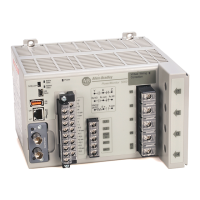Rockwell Automation Publication 1426-UM001J-EN-P - August 2019 505
Glossary
Sliding Demand Interval A method of calculating average demand by averaging the average demand over
several successive short time intervals, advancing one short time interval each
time. Updating average demand at short time intervals gives the utility a much
better measure of true demand and makes it difficult for the customer to obscure
high short-term loads.
Subharmonics AC waveform components at frequencies less than the fundamental frequency.
Swell Temporary increase in rms voltage magnitude above a preset threshold, typically
110% of nominal.
Swell Voltage The maximum rms voltage during a voltage swell.
TDD Total Demand Distortion, the ratio of the total rms harmonic content expressed
as a percent of the maximum demand current rms value. The maximum demand
current is the average of the maximum demand over the previous 12 months.
THD Total Harmonic Distortion, the ratio of the total rms harmonic content (either
voltage or current) expressed as a percent of the fundamental rms value.
Threshold A limit, either fixed or configurable, used to trigger an action when a measured
parameter is greater than (i.e. a swell condition) or less than (i.e. a sag condition)
the limit.
TID Total Interharmonic Distortion, the ratio of the total interharmonic rms content
(excluding any harmonic content) to the fundamental rms value.
Tr a nsie nt A waveform distortion with a duration of less than one cycle, can be either
impulsive or oscillatory. Typically caused by lightning or power device switching.
Unbalanced Load A situation existing in a three-phase alternating current system using more than
two current carrying conductors where the current is not due to uneven loading
of the phases.
Under voltage Voltage sag with a duration greater than one minute.
Volt amper e ( VA) The unit of apparent power. VA equals volts times amperes regardless of power
factor.
Volt a m p er e D em a nd Where peak average demand is measured in volt-amperes rather than watts. The
average VA during a predefined interval. The highest average, for example, Peak
VA demand, is sometimes used for billing.
Volt Ampere Reactive Hours
(VARH)
The number of VARs used in one hour. Because the value of this parameter
varies, it is necessary to integrate the parameter over time. VARs can be either
forward or reverse.
Vol ta g e ( V ) The force that causes current to flow through a conductor. One volt equals the
force that is required to produce a current flow of one ampere through a
resistance of one ohm.

